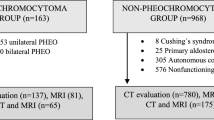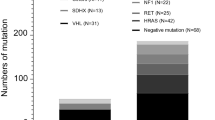Abstract
It is well known that no single histological feature is diagnostic for malignant pheochromocytomas (PCCs). So we developed a logistic model based on a series of clinical and pathological features to predict malignance in PCCs, and evaluated its diagnostic performance. In all 130 cases with malignant or benign PCCs, 15 predictive variables were observed and entered in the logistic regression analysis in a backward stepwise way. The diagnostic performance of this logistic model was evaluated by calculating the area under the receiver operating characteristic (ROC) curve. In logistic analysis, of the 15 variables entered in the logistic regression analysis, 9 were retained in the model. High cellularity had the highest odds ratio (OR), followed by spindle cell (>10% of tumor volume), atypical mitotic figure, periadrenal adipose tissue invasion, mitotic figures [>3/10 high-power field (HPF)], cellular monotony, capsular invasion, vascular invasion, and central or confluent tumor necrosis. High cellularity, spindle cell (>10% of tumor volume) and atypical mitotic figure were selected to built a logistic model. This model had the area under the ROC curve of 0.927 (95% confidence interval 0.883–0.971). The application of the model can benefit the clinical management decision for patients with PCCs. We still emphasize, however, that a clinical prospective evaluation is needed to confirm its actual value.

Similar content being viewed by others
References
Allibhai Z et al (2004) Malignant pheochromocytoma associated with germline mutation of the SDHB gene. J Urol 172(4 Pt 1):1409–1410
Anouar Y et al (2006) Development of novel tools for the diagnosis and prognosis of pheochromocytoma using peptide marker immunoassay and gene expression profiling approaches. Ann N Y Acad Sci 1073:533–540
Arnaldi G et al (2000) Adrenal incidentaloma. Braz J Med Biol Res 33(10):1177–1189
Aslam N et al (2000) Prospective evaluation of logistic regression models for the diagnosis of ovarian cancer. Obstet Gynecol 96(1):75–80
Bautista CV et al (2007) Telomerase activity is a prognostic factor for recurrence and survival in rectal cancer. Dis Colon Rectum 50:611–620
Brouwers FM et al (2006) Gene expression profiling of benign and malignant pheochromocytoma. Ann N Y Acad Sci 1073:541–556
Cassidy LD (2005) Basic concepts of statistical analysis for surgical research. J Surg Res 128:199–206
Favier J et al (2002) Angiogenesis and vascular architecture in pheochromocytomas: distinctive traits in malignant tumors. Am J Pathol 161(4):1235–1246
Melicow MM (1977) One hundred cases of pheochromocytoma (107 tumors) at the Columbia-Presbyterian Medical Center, 1926–1976: a clinicopathological analysis. Cancer 40(5):1987–2004
Modlin IM et al (1979) Phaeochromocytomas in 72 patients: clinical and diagnostic features, treatment and long term results. Br J Surg 66(7):456–465
Obuchowski NA (2005) ROC analysis. AJR Am J Roentgenol 184(2):364–372
Salmenkivi K et al (2001) Inhibin/activin betaB-subunit expression in pheochromocytomas favors benign diagnosis. J Clin Endocrinol Metab 86(5):2231–2235
Salmenkivi K et al (2001) Increased expression of cyclooxygenase-2 in malignant pheochromocytomas. J Clin Endocrinol Metab 86(11):5615–5619
Scott HW Jr et al (1982) Clinical experience with malignant pheochromocytomas. Surg Gynecol Obstet 154(6):801–818
Segawa N, Osafune T (2005) Malignant pheochromocytoma of the urinary bladder. Hinyokika Kiyo 51(4):291–296
Steyerberg EW et al (2004) Validation and updating of predictive logistic regression models: a study on sample size and shrinkage. Stat Med 23(16):2567–2586
Vergouwe Y et al (2005) Substantial effective sample sizes were required for external validation studies of predictive logistic regression models. J Clin Epidemiol 58(5):475–483
Wada K et al (2005) Chromosomal and genetic abnormalities in benign and malignant meningiomas using DNA microarray. Neurol Res 27(7):747–754
Author information
Authors and Affiliations
Corresponding author
Rights and permissions
About this article
Cite this article
Gao, B., Sun, Y., Liu, Z. et al. A logistic regression model for predicting malignant pheochromocytomas. J Cancer Res Clin Oncol 134, 631–634 (2008). https://doi.org/10.1007/s00432-007-0261-6
Received:
Accepted:
Published:
Issue Date:
DOI: https://doi.org/10.1007/s00432-007-0261-6




